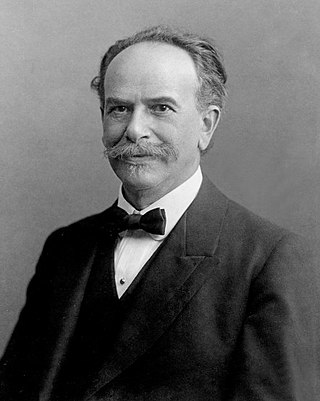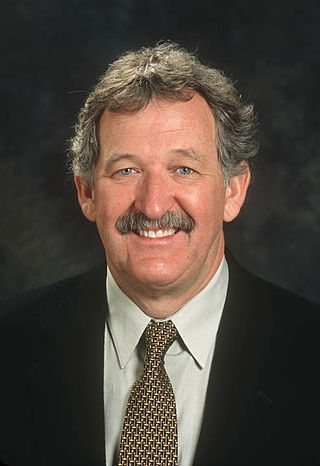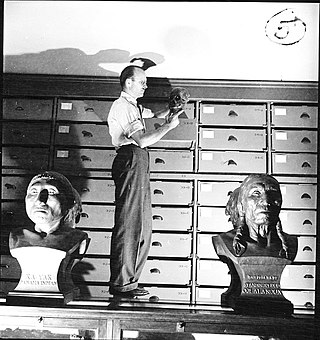
Franz Uri Boas was a German-American anthropologist and a pioneer of modern anthropology who has been called the "Father of American Anthropology". His work is associated with the movements known as historical particularism and cultural relativism.

The National Museum of Natural History is a natural history museum administered by the Smithsonian Institution, located on the National Mall in Washington, D.C., United States. It has free admission and is open 364 days a year. In 2021, with 7.1 million visitors, it was the eighteenth most visited museum in the world and the second most visited natural history museum in the world after the Natural History Museum in London. Opened in 1910, the museum on the National Mall was one of the first Smithsonian buildings constructed exclusively to hold the national collections and research facilities. The main building has an overall area of 1.5 million square feet (140,000 m2) with 325,000 square feet (30,200 m2) of exhibition and public space and houses over 1,000 employees.

Museology or museum studies is the study of museums. It explores the history of museums and their role in society, as well as the activities they engage in, including curating, preservation, public programming, and education.

Alois Ferdinand Hrdlička, after 1918 changed to Aleš Hrdlička, was a Czech anthropologist who lived in the United States after his family had moved there in 1881. He was born in Humpolec, Bohemia.

Yohannes Haile-SelassieAmbaye is an Ethiopian paleoanthropologist. An authority on pre-Homo sapiens hominids, he particularly focuses his attention on the East African Rift and Middle Awash valleys. He was curator of Physical Anthropology at the Cleveland Museum of Natural History from 2002 until 2021, and now is serving as the director of the Arizona State University Institute of Human Origins. Since founding the institute in 1981, he has been the third director after Donald Johanson and William Kimbel.

Ian Tattersall is a British-born American paleoanthropologist and a curator emeritus with the American Museum of Natural History in New York City, New York. In addition to human evolution, Tattersall has worked extensively with lemurs. Tattersall is currently working with the Templeton Foundation.

The National Anthropological Archives is a collection of historical and contemporary documents maintained by the Smithsonian Institution, which document the history of anthropology and the world's peoples and cultures. It is located in the Smithsonian's Museum Support Center in Suitland, Maryland, and is part of the Department of Anthropology at the National Museum of Natural History.
John Gurche is an American artist known for his paintings, sculptures, and sketches of prehistoric life, especially dinosaurs and early humans. Gurche is currently an Artist in Residence at the Museum of the Earth in Ithaca, New York. Gurche studied Anthropology and Paleontology at the University of Kansas, but his study of art was limited to his days in middle school. Also while in middle school, Gurche attempted to create a "family tree for all animal life," and fashioned an evolutionary series of heads from clay while in fourth grade.

Olorgesailie is a geological formation in East Africa, on the floor of the Eastern Rift Valley in southern Kenya, 67 kilometres (42 mi) southwest of Nairobi along the road to Lake Magadi. It contains a group of Lower Paleolithic archaeological sites. Olorgesailie is noted for the large number of Acheulean hand axes discovered there that are associated with animal butchering. According to the National Museums of Kenya, the finds are internationally significant for archaeology, palaeontology, and geology.

Museum anthropology is a domain of scholarship and professional practice in the discipline of anthropology.
Adrienne Lois Kaeppler was an American anthropologist, curator of oceanic ethnology at the National Museum of Natural History at the Smithsonian Institution in Washington, DC. She served as the President of the International Council on Traditional Music between 2005 and 2013. Her research focused on the interrelationships between social structure and the arts, including dance, music, and the visual arts, especially in Tonga and Hawaii. She was considered to be an expert on Tongan dance, and the voyages of the 18th-century explorer James Cook.
C. Wesley Cowan is an American anthropologist, auctioneer, and appraiser of antiques. He is an owner of Cowan's Auctions, Inc. in Cincinnati, Ohio.
John Daniel Rogers, Ph.D. is a Curator of Archaeology in the Department of Anthropology at the National Museum of Natural History (NMNH) at the Smithsonian Institution in Washington, DC. He is well known for his archaeological work with the Spiro Mounds in Oklahoma and other sites in the southeastern United States, and has studied the rise of chiefdoms and empires across the world.

William Wyvill Fitzhugh IV is an American archaeologist and anthropologist who directs the Smithsonian’s Arctic Studies Center and is a Senior Scientist at the National Museum of Natural History. He has conducted archaeological research throughout the circumpolar region investigating cultural responses to climate and environmental change and European contact. He has published numerous books and more than 150 journal articles, and has produced large international exhibitions and popular films. Of particular note are the many exhibition catalogues he has had edited, which make syntheses of scholarly research on these subjects available to visitors to public exhibitions.

Anna Katherine "Kay" Behrensmeyer is an American taphonomist and paleoecologist. She is a pioneer in the study of the fossil records of terrestrial ecosystems and engages in geological and paleontological field research into the ecological context of human evolution in East Africa. She is Curator of Vertebrate Paleontology in the Department of Paleobiology at the Smithsonian Institution's National Museum of Natural History (NMNH). At the museum, she is co-director of the Evolution of Terrestrial Ecosystems program and an associate of the Human Origins Program.

Bruce D. Smith is an American archaeologist and curator at the Smithsonian Institution's National Museum of Natural History who primarily focuses on the interaction of humans with their environment, especially the origins of agriculture in eastern North America agricultural complex.

African Genesis: A Personal Investigation into the Animal Origins and Nature of Man, usually referred to as African Genesis, is a 1961 nonfiction work by the American writer Robert Ardrey. It posited the hypothesis that man evolved on the African continent from carnivorous, predatory ancestors who distinguished themselves from apes by the use of weapons. The work bears on questions of human origins, human nature, and human uniqueness. It has been widely read and continues to inspire significant controversy.

Dawn of Humanity is a 2015 American documentary film that was released online on September 10, 2015, and aired nationwide in the United States on September 16, 2015. The PBS NOVA National Geographic film, in one episode of two hours, was directed and produced by Graham Townsley. The film describes the 2013 discovery, and later excavation, of the fossil remains of Homo naledi, an extinct species of hominin assigned to the genus Homo, found within the Dinaledi Chamber of the Rising Star Cave system, located in the Cradle of Humankind, South Africa. Additionally, the National Geographic Society has multiple videos on its website covering different phases of the discovery and excavation of the fossils during a two-year period. As of September 2015, fossils of at least fifteen individuals, amounting to 1550 specimens, have been excavated from the cave.

Thomas Dale Stewart was a founder of modern forensic anthropology and a major contributor to most areas of human skeletal biology, paleopathology, and related areas of physical anthropology. Stewart was known to have a more even temperament than his mentor, Aleš Hrdlička. Stewart began his career in 1927 as an Aid to Hrdlička in the Division of Physical Anthropology of the United States National Museum at the Smithsonian Institution. He advanced to Curator of the Division in 1942 and to Head Curator of the Department of Anthropology in 1961. In 1963, he was appointed Director of the National Museum of Natural History and also served as Acting Assistant Secretary for Science in 1964. He retired from administration in 1966 to pursue his research as Senior Anthropologist. Upon his retirement in 1971, he was appointed Anthropologist Emeritus.
Lucile Eleanor St. Hoyme was an American biological anthropologist who conducted research related to human variation, bioarcheology, and paleopathology. St. Hoyme served as an Assistant Curator in the Department of Anthropology at the National Museum of Natural History. St. Hoyme analyzed human remains excavated from the John Kerr Reservoir Basin using a new bioarcheological approach combining data from other disciplines. Beyond her work with the Smithsonian collections, St. Hoyme also worked on FBI forensic cases in the 1960s with National Museum of Natural History Anthropology Curator J. Lawrence Angel.















